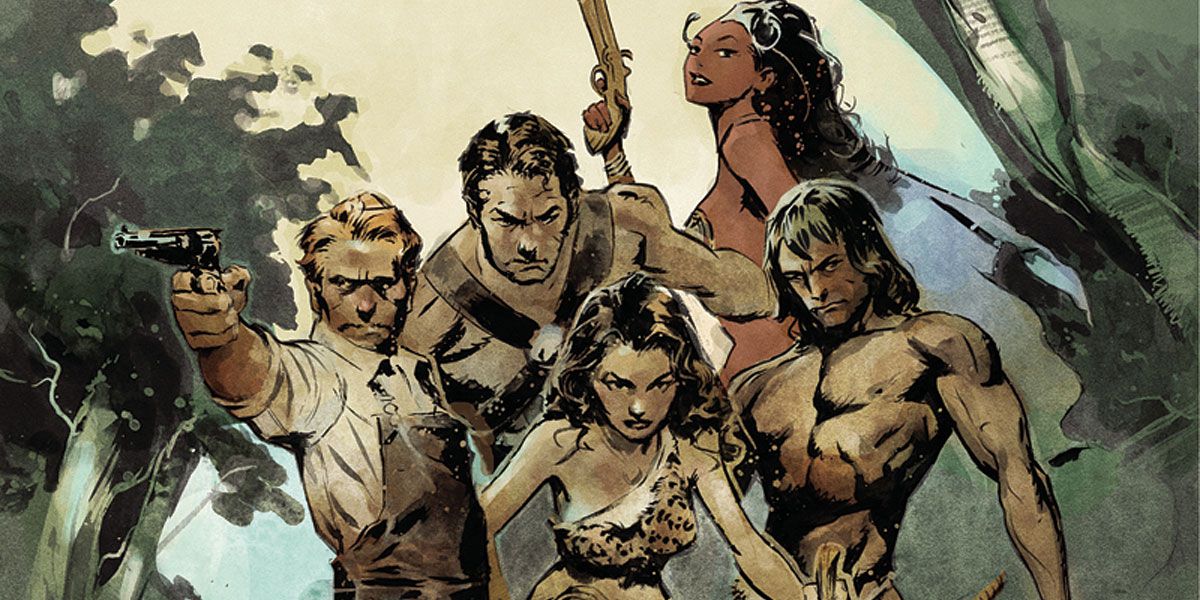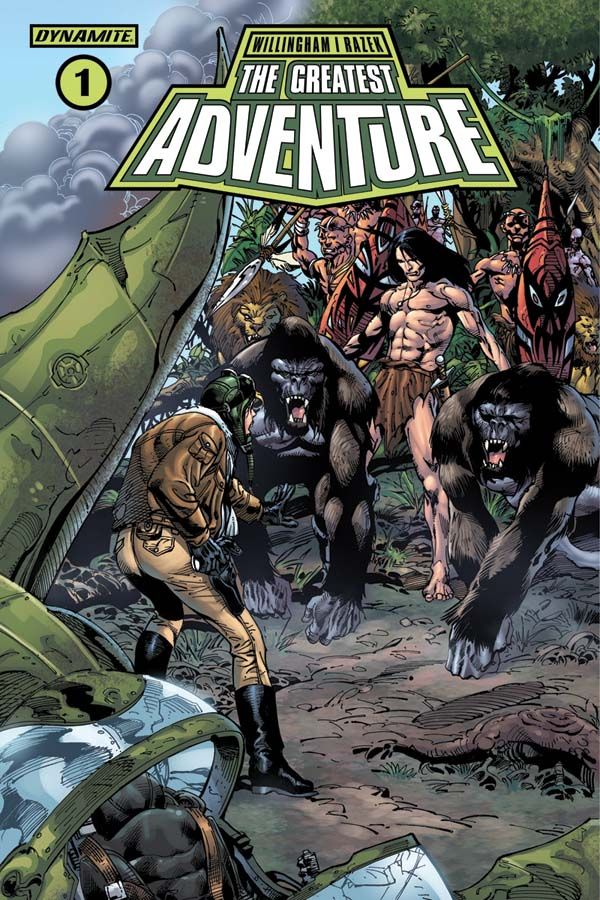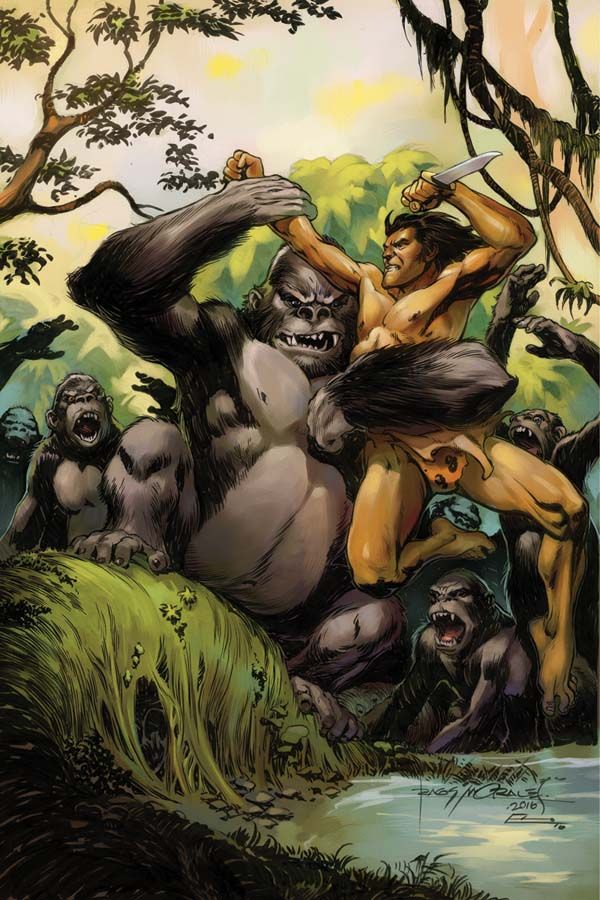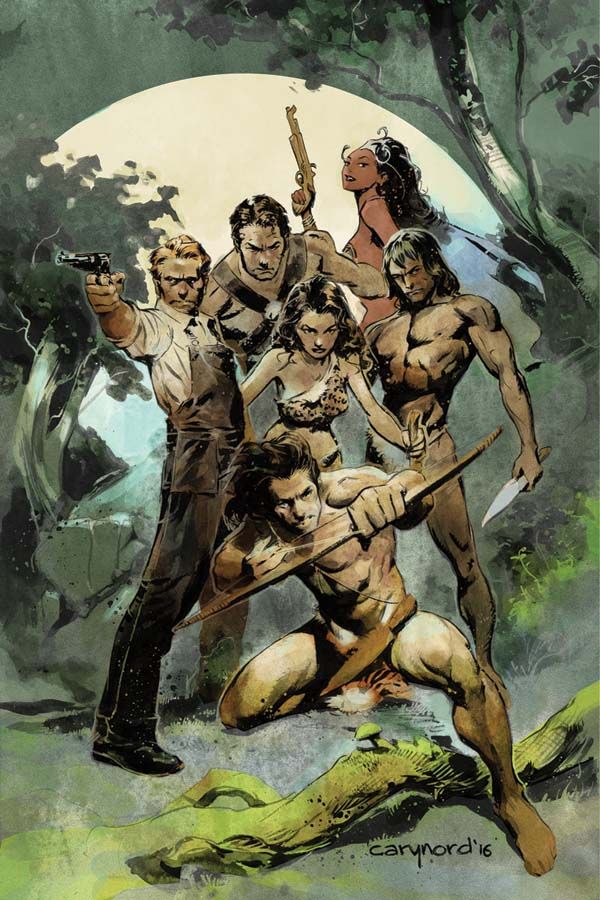When Bill Willingham was a young boy, his mother would buy him comic books when he stayed home sick to occupy him while she maintained her home-based accounting business. One day, she betrayed him (his words) and brought home "The Return of Tarzan" by Edgar Rice Burroughs instead.
Due to sheer boredom, the disheartened child eventually cracked the spine of his new paperback novel, only to discover a wonderful world of action and adventure. His mother's betrayal led to a lifelong love of the Lord of the Apes and the collected works of Burroughs that has lasted to this day, the writer told CBR. That's why his latest project, illustrated by Cezar Razek, has filled him with joy and some heart-felt trepidation.
In "The Greatest Adventure," an upcoming series from Dynamite Entertainment, Willingham is set to tell a story Burroughs never managed to deliver himself: the meeting of his two most iconic characters, Tarzan and John Carter of Mars. That, Willingham revealed, is why this is the most intimidating series that he has ever done, as he first imagined the possibility of such a meeting more than 50 years ago as a young reader.
The seven, eight or possibly nine-issue series will also feature many of Burrough's other classic characters, including Tarzan's immediate family (Jane Porter, his son Korak and his daughter-in-law Meriem), Jason Gridley from the Pellucidar series, and Billy Byrne from the Mucker series, as well as the little known Townsend Harper from "The Monster Men" and Kolani/Jim Stone from "The Resurrection of Jimber-Jaw."
CBR: In "Fables," you mashed together hundreds of characters from fairytales and folklore together in Fabletown, but -- am I right in thinking Edgar Rice Burroughs very much wrote these characters as if they already existed in a shared universe?
Bill Willingham: That's right. As a matter of fact, the discovery of that was a particularly fine moment for me. At first, it didn't quite click because I read one of the books from the Tarzan series out of order. It was called "Tarzan at the Earth's Core," in which Tarzan goes to the hidden, inner world of Pellucidar and meets and interacts with David Innes from the Pellucidar series. But at that time, I didn't realize there was a Pellucidar series. I just thought these were other interesting characters that Edgar Rice Burroughs had created for Tarzan to visit.
After that, I found out that there was a whole series of Pellucidar books. At the same time, I was a little disappointed because by the next book, Tarzan was off in some other recently discovered world. I was wishing that Tarzan could spend more time in Pellucidar. I ended catching up on the Pellucidar series, and that's when I found out all of this stuff all takes place in the same world.
I tried to read Edgar Rice Burroughs' books in order, but to a great extent, I was limited to what order that I discovered them. I found something called "The Mad King" that was part of a little two-book series that starred a character named Barney Custer. He was mistaken as the king of one of these fictionalized, Eastern European countries. His sister gets involved with a frozen caveman in a book called "The Eternal Lover," and at the beginning of that book, Barney Custer and his sister are hanging out in the Greystoke Manor in Africa, just having cocktails and such as you do in an Edgar Rice Burroughs novel. That's what finally cemented to me that all of this stuff takes place in the same world. I just went with that for this series.
One of the great disappointments amongst all of Edgar Rice Burroughs' fans is that, to anyone's knowledge, he never wrote the Tarzan on Mars book that you know should have been written. Tarzan and John Carter really, really needed to meet each other, and yet, it didn't happen. As a matter of fact, the issue that I am writing next is that meeting and the intimidation factor is dialed up about as high as it can be because it needs to be an important, big moment. Do I have the capability of doing it right? Probably not, but we'll see. [Laughs]
I loved "Fables," and a lot of that love came from your leading man, Bigby, aka the Big Bad Wolf. I didn't see it before, but in hindsight, there is a lot of Tarzan in Bigby. What attributes does Tarzan possess that allow him to stand front and center and lead these men and women on this greatest adventure?
This is very much the book version of Tarzan. He thinks in real thoughts. By this time in his life, he knows about 30 different languages. He is a savant in picking up languages, which retroactively justifies the almost impossible task of a kid teaching himself to read with just one primer and a few books in a cabin. He is clearly some kind of mental giant, but he is also, because of the way that he was raised, almost a stoic. He does not wear his heart on his sleeve. The intimate moments that he has with Jane, thank God, are for the most part off-screen.
One of the things that I like that Edgar Rice Burroughs said early on about Tarzan – and in later books, he contradicted this – is that he seldom smiled and never laughed. He is a dour fellow. Not in a sense that he doesn't have a sense of humor. He's not grimly serious all of the time, but he was raised in the jungle, and if you want to survive, you don't make extraneous noises. He learned from an early age to just keep things to himself. That's the Tarzan that I am hoping to show here. I think Tarzan also has an internal monologue, where he is constantly weighing and evaluating things, including his opinions on the people that he is surrounded by.
Tarzan, like most, is a character I know well from TV, movies, cartoons, books and comics. Jason Gridley is someone that I didn't know. What can you share about the character who actually brings this team together and basically appoints Tarzan to lead?
If you are going to do a take on Jason and the Argonauts, it helps to have a character named Jason. [laughs] Also, he is the scientist that invented the Gridley Wave, which is a means of instant communication that allowed Gridley to get full stories from people on Mars and David Innes down in Pellucidar. In the books, Edgar Rice Burroughs uses the Gridley Wave as a method of how he is able to tell you the story, because Edgar Rice Burroughs always wrote the books under the pretense that these stories really did happen.
This instant communication device that defies the limits of time and space also makes a very good MacGuffin in the sense that it gives the characters a reason to go on a quest because someone has taken the Gridley Wave with the intent to weaponize it. If you can communicate instantly, maybe you can do other, more terrible things, without having to worry about the barriers of time and space.
The bad guys actually capture Jason early on and try to get his cooperation in making his Gridley Wave into a death ray, but he escapes, gets a hold of Tarzan, and now we have a story. He's essential to the story.
By setting "The Greatest Adventure" in Burroughs' shared universe, does that mean that we also get to go back in time, to see Tarzan hunting dinosaurs in "The Land That Time Forgot" from the Caspak trilogy?
The biggest frustration with this entire series is that I have to keep it at a reasonable length. I am trying for seven issues, it's probably going to be eight -- dear God, it might have to expand into nine, but I can't over that simply because it has to be an enclosed story. But I'm telling you, with the structure of this, and visiting all of these lands that Edgar Rice Burroughs created, I could spend a dozen issues in each one of them. Some of that stuff will have to be truncated. I will give something away: Yes, you are going to see Tarzan hunt a dinosaur in at least one point.
The best thing that was ever done on TV, animation-wise, and will never be beaten is one scene from an episode of "Jonny Quest." Race, Johnny, Johnny's dad and probably Hadji are in personal flying packs with bazookas hunting dinosaurs. That's got it all. There is a nod to that fully formative moment in my life in this series, too, because as everyone who has read their Edgar Rice Burroughs knows, Martian Barsoomian tech includes something called the Equilibrimotor. It's one of ERB's most wonderful inventions with a terrible name, except that the name grows on me because it's so terrible, it's kind of charming. [Laughs]
Basically, they are flying harnesses -- and they are almost never used in the books. They are used a few times, but as a reader, there were so many times in the Martian books where I was like, "This would be a good time to use an Equilibrimotor." But who listens to me? But because that's part of the tech available to the crew now, there will be a scene where there are a few characters flying around, hunting dinosaurs with Martian exploding bullet rifles and bazookas. Just because, why not?
We've talked about Tarzan and John Carter of Mars, Burroughs' two most popular and enduring characters, but reading the scripts for the first two issues of this series also introduced me to a number of Burroughs' creations that I never knew existed. I am very excited to go out and read "The Monster Men," now.
"The Monster Men" takes place in Burma or one of the Far East countries. It's an adventure where there is a mad scientist – Burroughs loved his mad scientists – and this one was doing the Frankenstein bit, attempting to create new human life from the ground up. In his case, he was growing them in vats, not sewing corpses together. The experiments were not successful, at least not right away, so you have a lot of grotesque monstrosities running around outside of this guy's lab. Experiment Number Thirteen turns out to be the success amongst all of these failures. He looked entirely human, he was handsome, he was noble and the mad scientist's daughter, of course, fell in love with him. In the book, and I hope I am not giving too much away, it turns out that he was human after all, and he had amnesia. He was basically clunked over the head and put in there to fake out the scientist that he had actually created a person. It's a long and complex story, but yes, Experiment Number Thirteen from "The Monster Men" is part of the crew. [Laughs]
Just because, why not?
Exactly. If I am going to do this, why not wallow in it? [Laughs] We also have the writer from one book. We have The Oskaloosa Kid, a gunslinger from "The Oakdale Affair." We have the Mucker, who starred in two books. He's the closest thing we have to a thuggish brute that Burroughs ever wrote. Burroughs also wrote a morality play about what a nest of vipers Hollywood is. It was a snarky look at Hollywood after Burroughs went there with Tarzan. The book was called "The Girl from Hollywood" and so she's in the crew. And I have to tell you, there was absolutely no reason to justify putting her in the crew other than another 'why not' but then it turned out -- as it so often happens when you put some things in there that I know at the right time, I am confident, will pay off and I will figure out something to do with them – and that did happen with her. She became important to one part of the story at just right the time.
The Greatest Adventure," by Bill Willingham and illustrated by Cezar Razek, begins on April 19.




